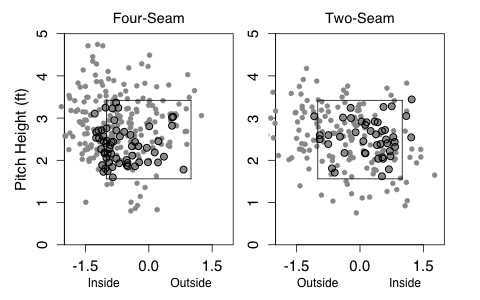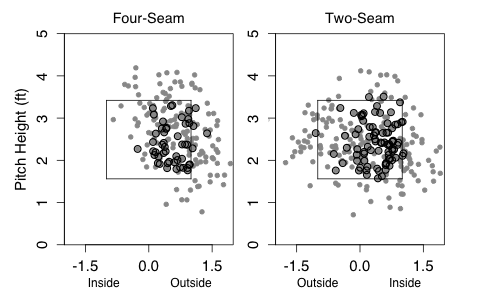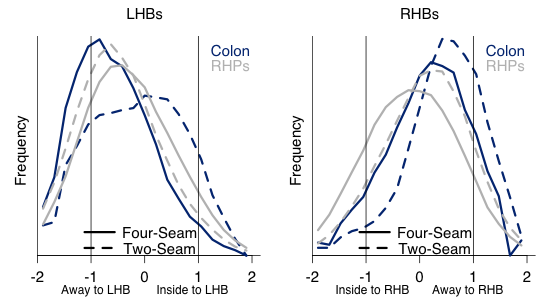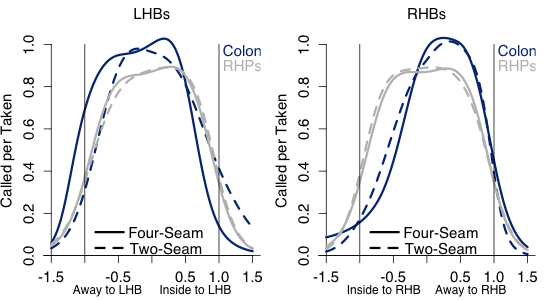
| F/X Visualizations | July 08, 2011 |
Last night Bartolo Colon threw a clunker fo the New York Yankees against the Tampa Bay Rays. But, what makes that clunker so amazing is that after twelve starts for the Yankees this was just the third bad start for Colon. After not pitching in 2010 and with just limited success since 2005, Colon's 2011 has been a major surprise. He is striking out 7.9 batters per nine innings, the best since 2001, while maintaining his great command.
Colon is getting the majority of these strikeouts on called strikes. Typically high-strikeout guys get lots of swinging strikes, and Jeff Sullivan showed that swinging-strike rate correlates very well with strikeout rate. But Colon is in the bottom ten among starters at getting swinging strikes, but is solidly above average at getting strikeouts. Jeff Sullivan actually wrote about this strange fact back in May. Colon's strikeouts are coming overwhelmingly on called strikes. He has the highest rate of called strikes (called strikes per pitches) among pitchers with over 500 pitches at 23.7%. The major league average is 17.5%, the next highest is Carlos Marmol with 23.1% and the next starting pitcher is Kyle Lohse with 21.9%.
Colon throws almost all fastballs, 84%. That makes the called strikes that much more interesting. Batters almost surely know that a fastball is coming, but Colon gets takes in the zone anyway. A big part of this comes down to location. Here are the locations of his two- and four-seam fastballs in 2011, with called strikes circled.
To left-handed batters:

To right-handed batters:

He paints the four-seam fastball on the outer half of the plate, and just piles up called strikes. The two-seam fastball he throws over a wider swath of the plate, but still gets called strikes even over the heart of the plate — most likely from the two-seamer's heavy sink and tail.
Here are three possible — though non-exhaustive and nonexclusive — explanations for his called strikes: (a) Colon hits the corners better than other pitchers; (b) hitters take his pitches in the zone more often than against other pitchers; and (c) umpires call his taken pitches on the edges more often than other pitchers.
Looking at (a):

To left-handed batters Colon does throw his four-seam fastball more consistently away than most right-handed pitchers. But his two-seam is throw across the zone, and much more inside than most right-handed pitchers will throw it. Against right-handed batters he goes more consistently away with both his two- and four-seam fastballs than the average pitcher. This already could account for the additional called strikes because these pitches right on the edge of the zone should be more likely to be taken.
Turing to (b), here I just look at pitches that are vertically in the zone (between sz_top and sz_bot):

Against left-handed batters Colon gets considerable more swings away on his two-seamer, but fewer inside. This works well for him as he often throws the two-seam inside to lefties. It looks like they aren't expecting it and often take it. Against right-handed batters he gets swings at about the same rate as average. The swings on his inside four-seamers are probably just noise because he rarely throws inside four-seamers to right-handed batters.
Finally looking at (c), again these are pitches within the zone vertically:

Generally Colon gets more called strikes than average. This could be because he gets the benefit of the doubt since he is always around the zone. Or because his pitches are vertically closer to the center of the zone than the average pitcher's. That is even though I am just looking at pitches between the top and bottom of the zone, Colon's could still be, on average, closer to the heart of the zone. But either way Colon is getting more called strikes on taken pitches.
Overall Colon benefits from all three possible factors: he throws more pitches on the edge of the zone than the average pitcher; his inside two-seam fastball is taken at a very high rate; and his taken pitches are more likely to be called strikes. His last start not withstanding, I am not sure whether he can keep this up. Maybe the league will get on to him and start swinging at his pitches more often. Historically it has been very hard to keep a strikeout rate that high missing so few bats.
Comments
Great stats and analysis
Posted by: Cyril Morong at July 9, 2011 10:24 AM
Thanks Cyril.
Posted by: Dave Allen at July 9, 2011 11:08 AM
Good job, Dave. I was skeptical prior to the season (and have been proven wrong) but your pitchf/x work brings into question the sustainability of his strikeout rate the rest of the way. Add in the fact that Colon hasn't thrown 100 innings in the majors since his Cy Young Award season in 2005 and one has to wonder if the combo of health/endurance and results can be maintained for close to three more months. I'm inclined to bet the "don'ts" for the second time this season. Maybe I can get back to .500.
Posted by: Rich Lederer at July 9, 2011 9:38 PM